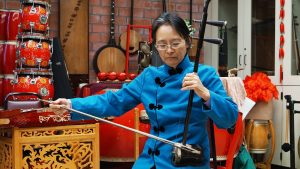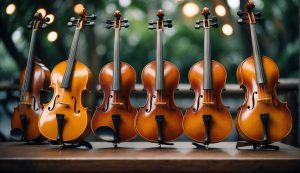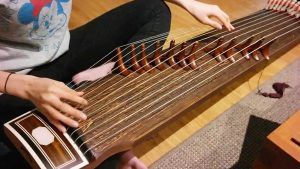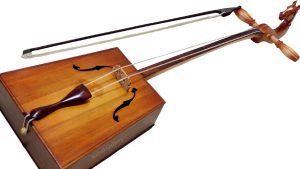Folkstrings.com is reader-supported. When you buy through links on our site, we may earn a small commission.
Stringed instruments have been a part of Asian music for centuries, with each country having its own unique styles and instruments. From the Koto of Japan to the Erhu of China, Asian stringed instruments have a rich history and continue to be an important part of traditional and contemporary music.
These instruments are typically made from wood or other natural materials and are played with a bow or plucked with fingers.
Understanding the construction, tuning, and playing techniques of these instruments is important in order to appreciate their unique sound and cultural significance.
Key Takeaways
- Asian stringed instruments have a long history and are an important part of traditional and contemporary music in Asia.
- These instruments are typically made from natural materials and are played with a bow or plucked with fingers.
- Understanding the construction, tuning, and playing techniques of these instruments is important to appreciate their unique sound and cultural significance.
Historical Overview of Asian Stringed Instruments
Stringed instruments have a rich history in Asian culture, with some instruments dating back to ancient times. Traditional Asian stringed instruments are known for their unique sound and design, which are often influenced by the culture and traditions of the region.
In China, the tradition of playing stringed instruments can be traced back to the Tang Dynasty (618-907 AD). During this time, the guzheng, a traditional Chinese plucked zither, was developed. The guzheng is still widely used in Chinese music today and is considered to be one of the most important traditional Chinese instruments.
From the ancient guzheng of China to the sitar of India, these instruments have played a significant role in traditional music for centuries.
Other popular traditional Chinese stringed instruments include the erhu, a two-stringed bowed instrument, and the pipa, a four-stringed plucked instrument. These instruments have been used for centuries in Chinese music and are still widely played today.
In other parts of Asia, stringed instruments have also played an important role in traditional music. In Japan, the koto is a popular traditional instrument that has been used for over a thousand years. The koto is a plucked zither with thirteen strings and is often played in traditional Japanese music.
In India, the sitar is a popular stringed instrument that has been used for centuries in classical Indian music. The sitar has a long neck and a pear-shaped body and is played with a plectrum.
Understanding Stringed Instruments
Stringed instruments are found in many cultures around the world, with each culture having its unique style and type of stringed instrument. Some of the most popular stringed instruments include the guitar, violin, cello, and bass. However, in many Asian cultures, there are a variety of stringed instruments that are unique to their region.
One of the most important components of a stringed instrument is the bridge. The bridge is a small piece of wood that is placed on the instrument’s body and holds the strings in place. The bridge also helps to transmit the vibrations of the strings to the instrument’s body, which amplifies the sound.
Another important part of a stringed instrument is the tuning pegs. These are used to adjust the tension of the strings, which in turn changes the pitch of the sound produced. Tuning pegs can be made from a variety of materials, including metal, wood, and plastic.
Stringed instruments can be played in a variety of ways, including plucking, bowing, and strumming. The technique used to play a stringed instrument can have a significant impact on the sound produced. For example, a violin can produce a variety of sounds depending on how it is played, including a smooth and mellow sound when played with a bow or a sharp and staccato sound when plucked.
Types of Asian Stringed Instruments
Asian stringed instruments are a diverse and fascinating group of musical instruments that have been played for centuries. Here are some of the most popular types of Asian stringed instruments:
Zithers
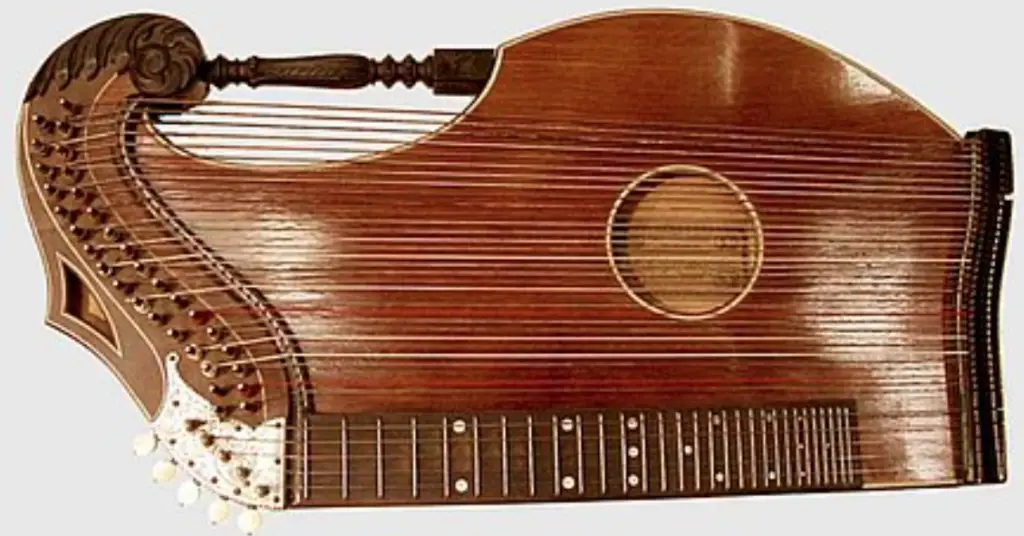
Zithers are a type of stringed instrument that are played by plucking or strumming the strings. They are popular across Asia, and each country has its own unique style. Some of the most popular zithers include the guzheng from China, the qin from China, and the koto from Japan.
Zhengs
Zhengs are a type of zither that are popular in China. They are played by plucking the strings with the right hand while using the left hand to press down on the strings to change the pitch. The guzheng is the most popular type of zheng.
Huqins
Huqins are a type of bowed stringed instrument that are popular in China. They are played by drawing a bow across the strings while using the left hand to change the pitch. Some of the most popular huqins include the erhu and the gaohu.
Yangqin
The yangqin is a type of hammered dulcimer that is popular in China. It is played by striking the strings with small hammers while using the left hand to dampen or sustain the notes.
Koto
The Koto is a traditional Japanese stringed instrument that has been in use for centuries. It has 13 strings that are usually made of silk or nylon.
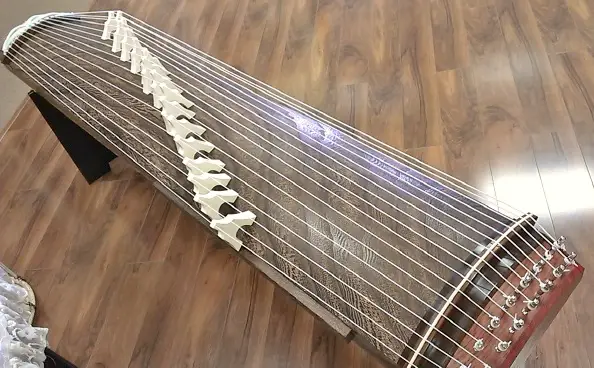
The Koto is played by plucking the strings with picks called Tsume. It is a popular instrument in traditional Japanese music and is often used in ensembles.
Dan Tranh
Dan Tranh is a traditional Vietnamese stringed instrument that has 16 strings. The strings are made of nylon or silk and are tuned to a pentatonic scale. The Dan Tranh is played by plucking the strings with the fingers. It is a popular instrument in Vietnamese folk music and is often used in ensembles.
Asian stringed instruments are known for their unique sound and design. Each instrument has its own distinct characteristics and is often used in traditional and contemporary music.
Shamisen
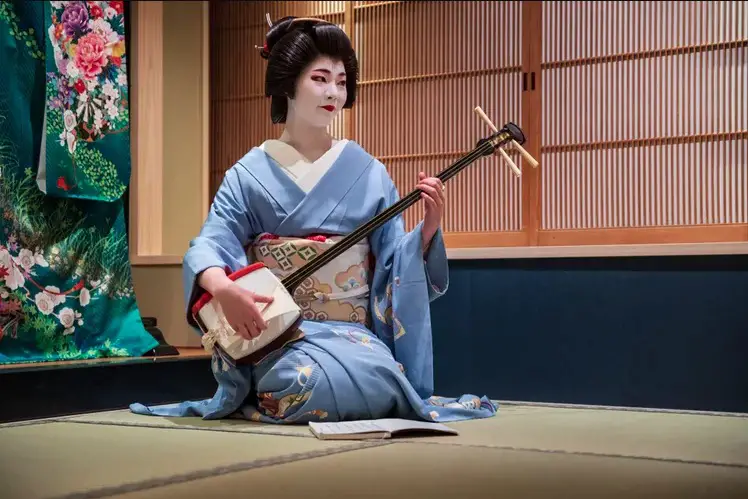
The Shamisen is a traditional Japanese stringed instrument that has three strings. It is similar to the Chinese Sanxian and the Okinawan Sanshin. The Shamisen is played by plucking the strings with a plectrum called a Bachi. It is a popular instrument in Japanese folk music and is often used in ensembles.
Guzheng
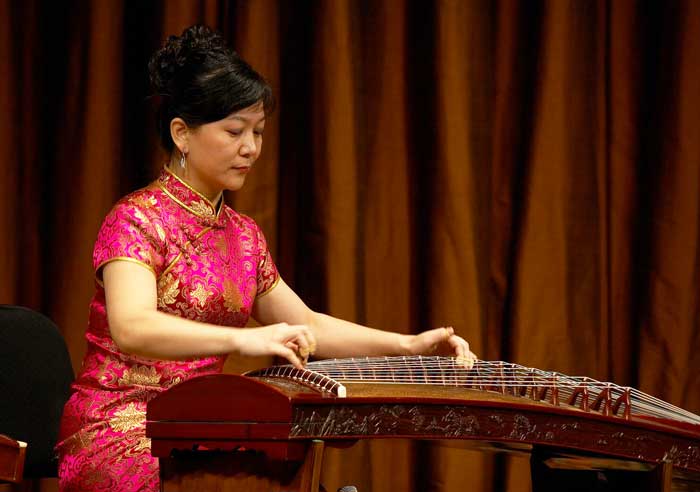
The Guzheng is a traditional Chinese stringed instrument that has 21 strings. It is often referred to as the Chinese zither. The strings are made of silk or nylon and are tuned to a pentatonic scale. The Guzheng is played by plucking the strings with the fingers. It is a popular instrument in Chinese classical music and is often used in ensembles.
Sanshin and Sanxian
The sanshin and sanxian are both types of three-stringed lutes that are popular in Okinawa and China respectively. They are played by plucking the strings with the right hand while using the left hand to press down on the strings to change the pitch.
The Sanshin is the national instrument of Okinawa, a prefecture in Japan. It has three strings and is similar to the Shamisen. The Sanshin is played by plucking the strings with a plectrum called a Bachikawa.

It is a popular instrument in Okinawan folk music and is often used in ensembles.
Overall, Asian stringed instruments are a rich and diverse group of musical instruments that have been played for centuries. Each country has its own unique style, and there are many different types of instruments to choose
Materials and Construction
Asian stringed instruments are made from a variety of materials, including wood, silk, bamboo, and synthetic materials. The construction of these instruments is based on traditional techniques that have been passed down from generation to generation.
The neck of the instrument is usually made of hardwood, and the body may be made of thin wooden boards or bamboo. The strings are typically made of silk, nylon, or metal, and are attached to the body using a round bridge. Some instruments, such as the erhu, have a short neck, while others, like the sitar, have a longer neck with frets.
The koto, a traditional Japanese instrument, has 13 strings made of silk, which are stretched over a wooden body. The strings are tuned using movable bridges, which are adjusted to change the pitch of the notes. The nut of the koto is made of ivory or synthetic materials, and the instrument is played using finger picks.
The erhu, a two-stringed Chinese instrument, has a wooden body covered with python skin. The strings are made of silk or metal and are attached to the neck using a bamboo rod. The erhu is played using a bow made of horsehair.
The sitar, a plucked stringed instrument from India, has a long neck with frets and a gourd-shaped body. The strings are made of metal and are attached to the body using a bridge. The sitar is played using a plectrum made of metal or plastic.
Tuning and Playing Techniques
Playing techniques and tuning vary depending on the type of Asian stringed instrument. However, most of these instruments are plucked, bowed, or struck to produce music. In this section, we will explore some of the common techniques used to play these instruments.
Tuning
Tuning is an essential aspect of playing any musical instrument, and Asian stringed instruments are no exception. These instruments are usually tuned to a specific pitch, with most of them using a pentatonic scale. The tuning and pitch of Asian stringed instruments vary depending on the instrument and the music being played.
For example, the guzheng is tuned to a pentatonic scale and has a range of four octaves. The erhu, on the other hand, is tuned to a specific pitch and has a range of two octaves. The pipa is also tuned to a specific pitch and has a range of three octaves.
Playing Techniques
Asian stringed instruments can be played in various ways, including plucking, bowing, and striking. The techniques used to play these instruments vary depending on the instrument and the music being played.
For example, the guzheng is played using a plectrum or fingers to pluck the strings. The instrument is usually played while sitting down, with the player using both hands to play the strings and the fingerboard.
The erhu is played using a bow made of horsehair, which is rubbed against the strings to produce sound. The instrument is usually played while standing, with the player holding the instrument between their legs and using their left hand to press the strings against the fingerboard.
The pipa is played using a combination of plucking and striking techniques. The instrument is usually played while sitting down, with the player using their right hand to pluck the strings and their left hand to press the strings against the fingerboard.
Role in Traditional and Contemporary Music
Asian stringed instruments have played a significant role in traditional music for centuries. These instruments have been used in various genres of music, including pop, ensembles, Chinese music, Japanese music, folk music, orchestras, and solo performances. The sound produced by these instruments is unique and has become an essential part of Asian music.
In traditional music, percussion instruments such as gongs and drums are often used in combination with stringed instruments. The sound produced by these instruments creates a beautiful harmony that is soothing to the ears. The base of these instruments is made of wood, and the soundboard is made of silk or other materials. This combination of materials makes the sound produced by the instrument versatile and rich.
In Chinese music, stringed instruments such as the erhu and pipa are widely used. The erhu is a two-stringed instrument that is played with a bow made of horsehair. The pipa, on the other hand, is a four-stringed instrument that is played with a pick. Both instruments have a long history and are still used in contemporary music.
In Japanese music, the shamisen is a popular stringed instrument that is used in traditional and contemporary music. It is a three-stringed instrument that is played with a plectrum called a bachi. The shamisen is often used in rock and jazz music, and its unique sound adds depth to the music.
In folk music, stringed instruments such as the sitar, sarod, and tambura are used in Hindustani classical music. These instruments are played with a combination of plucking and strumming, and their sound is soothing and relaxing.
Asian stringed instruments are often combined with technology to create unique sounds. Musicians have found ways to extend the sound of traditional instruments using technology, creating a fusion of traditional and modern music.
Frequently Asked Questions
What are some traditional stringed instruments from East Asia?
These instruments have been used for centuries in traditional music and continue to be an important part of cultural heritage.
What is the history of Chinese opera?
Chinese opera has evolved over time, with different regional styles and variations.
What is the difference between the Chinese erhu and other Asian stringed instruments?
The erhu is often used in Chinese traditional music and has become popular in other genres as well.
What are the seven string instruments in Chinese music?
These instruments are all important in traditional Chinese music and have different sounds and playing techniques.
What is the significance of the number of strings on a Chinese instrument?
The pipa has four strings, which represent the four seasons.
What are some common techniques used to play traditional Asian stringed instruments?
The techniques can vary depending on the instrument and the style of music being played. Mastery of these techniques is essential to playing traditional Asian stringed instruments.
Author Profile
-
Daniel Johnstone is an English writer with a love for stringed instruments from around the world.
He shares his love for these instruments through his writing for folkstrings.com, a website dedicated to all things related to folk string music.
Daniel's passion for music started at a young age, and he has since become an accomplished musician, playing guitar, cavaco, and recently, the harp.
His dedication to learning and sharing his knowledge of stringed instruments is evident in his insightful and engaging blog posts. Whether you're a seasoned musician or a beginner, Daniel's writing is sure to inspire and entertain you.
When he's not playing music or writing, you can find Daniel exploring new instruments and seeking out new sounds to share with his readers.
Latest entries
 AutoharpApril 4, 2024Is Autoharp Easy to Play? Unveiling the Truth for Beginners
AutoharpApril 4, 2024Is Autoharp Easy to Play? Unveiling the Truth for Beginners AutoharpApril 4, 2024What Is an Autoharp Worth? Your Guide to Pricing and Value
AutoharpApril 4, 2024What Is an Autoharp Worth? Your Guide to Pricing and Value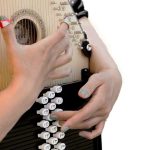 AutoharpApril 4, 2024Where Is the Best Place to Buy an Autoharp? Your Top Picks Reviewed
AutoharpApril 4, 2024Where Is the Best Place to Buy an Autoharp? Your Top Picks Reviewed AutoharpApril 4, 2024How Does the Autoharp Work? – Unveiling Its Melodic Secrets
AutoharpApril 4, 2024How Does the Autoharp Work? – Unveiling Its Melodic Secrets


